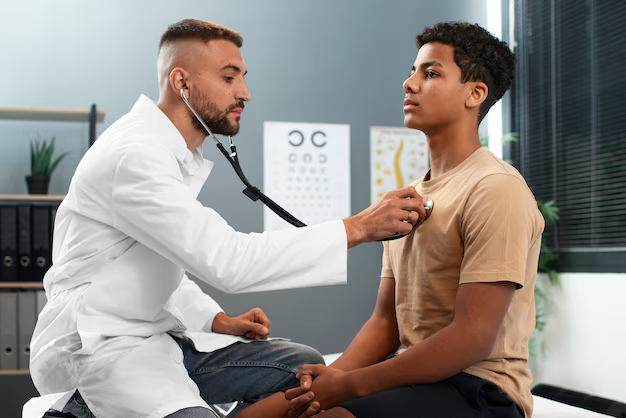Understanding the Process: How to Test for Lymphoma
If you or a loved one is facing the possibility of lymphoma, understanding the testing process can be a crucial step in managing the stress and anxiety that come with it. This guide will walk you through the different methods used to diagnose lymphoma, shedding light on what to expect and how these tests can lead to a clearer understanding of your health.
What is Lymphoma?
Lymphoma is a type of cancer that originates in the lymphatic system, which is an essential part of the body's immune network. It primarily affects white blood cells known as lymphocytes, which are crucial for fighting off infections. The two main types of lymphoma are Hodgkin lymphoma and non-Hodgkin lymphoma (NHL). Understanding the differences between these types and their subtypes is vital, as they can influence the diagnostic and treatment approaches.
Common Symptoms & When to Consult a Doctor
Lymphoma symptoms can often be mistaken for less severe conditions, so it's crucial to pay attention to persistent signs:
- Swollen lymph nodes in the neck, armpits, or groin
- Unexplained weight loss
- Fever and chills
- Night sweats
- Persistent fatigue
- Shortness of breath
If these symptoms persist for more than two weeks, it’s advisable to consult a healthcare professional who may recommend testing for lymphoma.
Steps in Testing for Lymphoma
Initial Medical Evaluation
A thorough medical evaluation is the first step in the diagnostic process:
- Medical History Review: Your doctor will ask about your symptoms, medical history, and any family history of cancer or immune system diseases.
- Physical Examination: This includes checking for swollen lymph nodes, spleen, or liver and assessing for unexplained injuries or visible symptoms.
Laboratory Tests
Laboratory tests play a crucial role in screening and diagnosis:
Complete Blood Count (CBC): Helps assess your overall health and detect a wide range of disorders, including infection, anemia, and other hematological issues.
Blood Chemistry Tests: These evaluate how well your liver and kidneys function, which might be affected by lymphoma or its treatment.
Imaging Studies
Imaging tests create a comprehensive picture of what might be happening inside your body:
X-Rays: Often the first imaging test; helps in visualizing swollen lymph nodes or any irregularities in the chest.
CT Scans: Provide detailed cross-sectional images of your body. CT scans confirm the location and size of a tumor, aiding in staging the disease.
PET Scans: Useful in determining lymphoma activity and assessing how well treatment is working by checking metabolic activity.
MRI Scans: Occasionally used to examine the brain or spinal cord if affected.
Biopsy Procedures
A definitive diagnosis usually relies on a biopsy, where a sample of tissue is extracted for examination:
Lymph Node Biopsy: The most common type used in diagnosing lymphoma, involves removing part or all of a lymph node.
Bone Marrow Biopsy: This test checks for lymphoma cells in the bone marrow and determines the spread of lymphoma.
Fine Needle Aspiration (FNA) Biopsy: Uses a thin needle to remove cells from a suspicious area, it’s less invasive but also less comprehensive.
Specialized Tests
Certain tests can provide more information about the specific type and aggressiveness of lymphoma:
Immunophenotyping: This test identifies specific cell types involved, helping in classifying the lymphoma subtype.
Cytogenetic Analysis: Examines the chromosomes within the cells, identifying genetic changes linked to lymphoma.
Molecular Tests: Detect specific genetic mutations and markers to fine-tune the diagnosis and guide treatment plans.
Making Sense of the Diagnosis
Once test results are in, understanding what they mean is crucial:
Staging Lymphoma: Determines the extent of cancer spread, ranging from Stage I (localized) to Stage IV (widespread). This influences treatment choices.
Grading: Indicates how aggressive the cancer is. High-grade lymphomas grow quickly and require more intensive treatment.
Understanding these factors helps in developing an effective treatment plan alongside your healthcare team.
Common Questions About Lymphoma Testing
How Long Does Testing Take?
The time frame for testing can vary based on the tests needed, but generally, expect it to take at least one to two weeks to complete all necessary diagnostics and await results.
Are These Tests Painful?
While some discomfort might be associated with certain procedures like biopsies, most tests are relatively straightforward. Health professionals will typically provide options for minimizing discomfort.
Can Lymphoma Be Detected Early?
Early detection significantly increases treatment success rates. Regular health check-ups and being vigilant about persistent symptoms are key.
The Road Ahead: Taking Charge of Your Health
Facing potential lymphoma can be daunting, but being informed about the testing process provides a sense of control and clarity. It empowers you to discuss your symptoms and understand the rationale behind each test with your healthcare provider.
Remember, while this guide serves as a comprehensive overview, every case is unique. It's essential to maintain open communication with your doctor, ask questions, and seek support as needed.
Summary of Key Steps in Testing for Lymphoma
- Consult a Doctor: If you notice persistent symptoms, schedule an appointment for a medical evaluation.
- Laboratory Tests: Include CBC and blood chemistry to rule out other conditions and assess overall health.
- Imaging Studies: Conduct X-rays, CT, PET, and MRI scans for detailed internal visualization.
- Biopsy Procedures: Necessary for definitive diagnosis; includes lymph node and bone marrow biopsies.
- Specialized Tests: Employ immunophenotyping and genetic analysis for precise subtype classification.
- Stay Informed: Be proactive in understanding test implications and treatment options.
Remember, detecting and addressing lymphoma early can dramatically improve outcomes. Stay informed, vigilant, and proactive in discussing any concerns with your healthcare provider.
